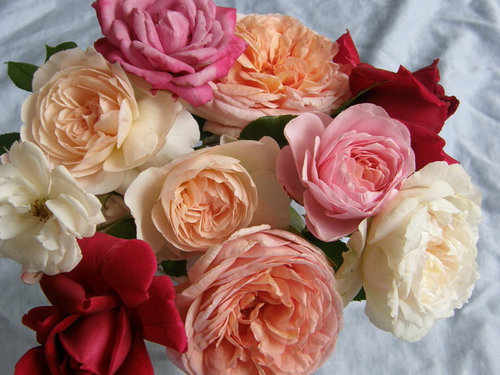This is for Carol, or PortlandMysteryrose
strawchicago z5
10 years ago
Hi Carol: In the below link, "your most tough and healthy rose", I need your help to go into what you posted, and delete info. you wrote about the new rose I'm raising from seed. Thank you.
Under patent law, any info. leaked from a new rose being bred, be it its name or parentage, is not wise. Thank you for keeping it confidential.
My experiment with low-salt Sulfate of Potash is a success. I bought 5 lbs. for $12, Epsoma brand, from a local nursery. Since I can't put horse manure on Eglantyne (prone to BS), I sprinkled sulfate of potash around before our 1-month rain. It's 100% clean.
Sufate of potash NPK is 0-0-50. High potassium helps to fight diseases, and 1/3 of soil tested is low in potassium (from EarthCo. soil testing booklet). Potassium is needed for strong root growth and flowering, plus strong stem.
Sulfate of potash also strengthen my Pat Austin's neck, blooms are much bigger than last year. In agriculture experiment with soybean, the yield with sulfate of potash and mulching with lime pellets BEAT the yield of using fungicide alone. It's free shipping from Kelp4Less, the powder form is best for dry climate. I use granular form, slow-release, since I have plenty of rain.
My blooms are much bigger this year. My Crimson Glory are 4" blooms once opened. Mirandy's bloom is almost 5" across. It's amazing how sulfate of potash made my blooms bigger! The bloom of "Deep Purple" in the below picture doesn't get sulfate of potash, quite small. Crimson Glory and Evelyn get sulfate of potash.
Thank you, Carol, for deleting the info. about the new rose I am raising from the below thread.

Here is a link that might be useful: Your most tough and healthy no-spray roses



portlandmysteryrose
ingrid_vc so. CA zone 9
strawchicago z5Original Author
strawchicago z5Original Author
Kippy
roseseek
Kippy
roseseek
seil zone 6b MI
strawchicago z5Original Author
strawchicago z5Original Author
portlandmysteryrose
User
strawchicago z5Original Author
portlandmysteryrose
strawchicago z5Original Author
portlandmysteryrose
strawchicago z5Original Author